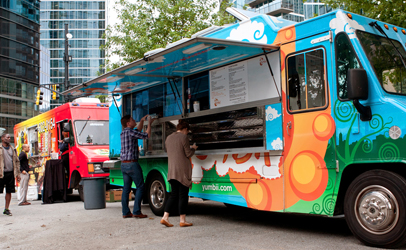
Food Safety on Food Trucks Called ‘A Little More of a Challenge’
It can take more to ensure that food is safe on a food truck than at a brick-and-mortar restaurant, says Bob Kramer, a registered sanitarian who provides training and technical assistance to entrepreneurs.
Kramer is the director of food safety and food services for a microlender in Ohio called the Economic and Community Development Institute and vice president of a consulting business called Savour Food Safety International. He spoke to a small audience at the Food Safety Summit in Baltimore on April 30 about what he tells people looking to launch a food truck.
Kramer told Food Safety News that he thinks it’s “a little more of a challenge” to ensure the safety of meals from food trucks compared to those served at traditional restaurants.
“We have to be concerned with the infrastructure of a food truck,” he explained. Unlike with a restaurant, a truck owner has to think about filling up the water tank, emptying waste water, finding power sources, and working within the limited time and space there is to sell.
But the layout of the equipment inside a food truck is similar to brick-and-mortar restaurants in order to follow the safe flow of food through the facility, Kramer said.
According to a study of food truck inspections that the Institute for Justice released last year, food trucks and carts have the same number of violations as restaurants, or fewer.
But another study conducted by the California Environmental Health Specialists Network (EHS-Net) noted that annual public health inspection of food trucks is usually scheduled and doesn’t occur during actual operation. This means that the trucks “are empty of food and water, and since no food preparation is occurring the evaluation of food and water safety risk factors is not possible,” the authors wrote.
The researchers assessed 95 mobile food trucks while in operation, and 90 of them exhibited at least one critical risk factor, including improper or no hand-washing, refrigerators not operating or with temperatures above 45 degrees F, internal food temperatures above 41 degrees F, cross-contamination with ready-to-eat foods, and inadequate or no sanitation of surfaces.
This is why standard operating procedures are so important to the success and safety of a food truck, Kramer said.
Some jurisdictions such as California and Washington, D.C., require that mobile food facilities have a certified food protection manager. Ohio doesn’t, but it’s something that Kramer said he supports given both his regulatory and industry background.
The authors of the California study wrote that impromptu field inspections of food trucks could help improve food safety and better protect public health.
“Without the ability to inspect mobile food trucks during actual operation, food safety risk factors that may occur could potentially lead to foodborne illness or death,” they wrote.
© Food Safety News
For additional information on OSHA training from Spectrum Training Services, visit our Illinois OSHA Training page.
Or if you interested in learning more about OSHA training NOW, please call 847-780-8944 and ask for Kenye. You can also use our Contact form.
